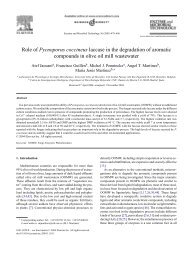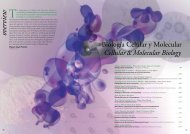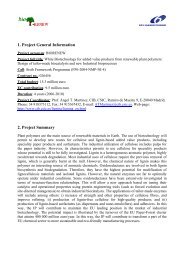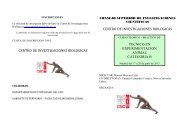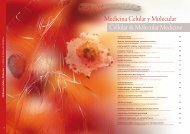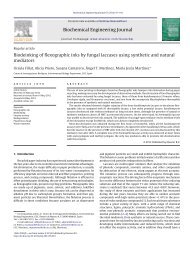Laccase purification and characterization from Trametes trogii ...
Laccase purification and characterization from Trametes trogii ...
Laccase purification and characterization from Trametes trogii ...
Create successful ePaper yourself
Turn your PDF publications into a flip-book with our unique Google optimized e-Paper software.
Enzyme <strong>and</strong> Microbial Technology 39 (2006) 141–148<strong>Laccase</strong> <strong>purification</strong> <strong>and</strong> <strong>characterization</strong> <strong>from</strong> <strong>Trametes</strong> <strong>trogii</strong> isolated inTunisia: decolorization of textile dyes by the purified enzymeHéla Zouari-Mechichi a , Tahar Mechichi a , Abdelhafidh Dhouib a , Sami Sayadi a ,Angel T. Martínez b , Maria Jesus Martínez b,∗a Centre de biotechnologie de Sfax BP “K” 3038, Tunisiab Centro de Investigaciones Biológicas (CSIC), Ramiro de Maeztu 9, E-28040 Madrid, SpainReceived 10 April 2005; received in revised form 9 November 2005; accepted 15 November 2005AbstractA white-rot basidiomycete, isolated <strong>from</strong> decayed acacia wood (<strong>from</strong> Northwest of Tunisia) <strong>and</strong> identified as <strong>Trametes</strong> <strong>trogii</strong>, was selected in abroad plate screening because of its ability to degrade commercial dyes. In liquid cultures using a glucose–peptone medium, the sole ligninolyticactivity detected was laccase. The highest laccase levels were obtained in presence of CuSO 4 as inducer (around 20000 U/l). Two isoenzymes,were purified using anion-exchange <strong>and</strong> size-exclusion chromatographies. Both isoenzymes are monomeric proteins, with M w around 62 kDa <strong>and</strong>isoelectric points of 4.3 <strong>and</strong> 4.5, showing similar stability at pH <strong>and</strong> temperature, optimum pH <strong>and</strong> substrate specificity. The highest oxidationrate was obtained at pH 2 <strong>and</strong> 2.5 for ABTS <strong>and</strong> DMP, respectively. They were stable up to 50 ◦ C for 24 h <strong>and</strong> the stability was higher at alkalinepH. Activity increased by the addition of 10 mM Ni, Mo or Mn but it was not affected by Cd, Al, Li <strong>and</strong> Ca. Identical N-terminal sequences weredetermined in both laccases. The crude enzyme, as well as the purified laccase, was able to decolorize dyes <strong>from</strong> the textile industry.© 2006 Elsevier Inc. All rights reserved.Keywords: Fungi; Basidiomycete; Enzymes; Industrial dyes; <strong>Trametes</strong> <strong>trogii</strong>1. IntroductionWhite rot fungi are believed to be the most effective lignindegradingmicrobes in nature. They produce different kinds ofextracellular oxidoreductases, including laccases [26], peroxidases[10] <strong>and</strong> oxidases producing H 2 O 2 [18]. These enzymesare involved in the degradation of lignin [20], but also ofother aromatic recalcitrant compounds causing environmentalproblems. Both laccases <strong>and</strong> peroxidases can catalyze theone-electron oxidation of aromatic lignin units, resulting in variousnon-enzymatic reactions. The peroxidases have the highestredox potential, being able to catalyze directly the oxidation ofnon-phenolic compounds. However, the use of oxygen (a nonlimitingelectron acceptor) by the laccases makes these enzymesmore adequate for industrial <strong>and</strong> environmental applications.∗ Corresponding author at: Centro de Investigaciones Biológicas, ConsejoSuperior de Investigaciones Científicas, Ramiro de Maeztu 9, E-28040 Madrid,Spain. Tel.: +34 918 373 112/34 915 611 800;fax: +34 915 360 432/34 915 627 518.E-mail address: mjmartinez@cib.csic.es (M.J. Martínez).<strong>Laccase</strong> is an enzyme secreted by the most of the lignindegrading basidiomycetes [23] <strong>and</strong> it has been reported as anessential enzyme for lignin degradation in fungi without peroxidases[15]. This enzyme catalyzes the oxidation of a widenumber of phenolic compounds <strong>and</strong> aromatic amines but itssubstrate range have been extended to non-phenolic compoundsin the presence of low molecular mass compounds acting asmediators [5,14]. Most of the studies have been carried out withlaccases <strong>from</strong> eukaryotes, principally with enzymes secretedby basidiomycetes being their distribution in prokaryotes morerecently reported [7].The textile industry, by far the most avid user of syntheticdyes, is in need of ecologically efficient solutions for its coloredeffluents. Wastewaters <strong>from</strong> textile industries are a complex mixtureof many polluting substances such as organochlorine-basedpesticides, heavy metals, pigments <strong>and</strong> dyes. Dye effluents arepoorly decolorized by conventional biological wastewater treatments<strong>and</strong> may be toxic for the microorganisms present in thetreatment plants due to their complex aromatic structures. Furthermore,following anaerobic digestion, nitrogen-containingdyes are transformed into aromatic amines that are more toxic<strong>and</strong> mutagenic than the parent molecules. To overcome these0141-0229/$ – see front matter © 2006 Elsevier Inc. All rights reserved.doi:10.1016/j.enzmictec.2005.11.027
142 H. Zouari-Mechichi et al. / Enzyme <strong>and</strong> Microbial Technology 39 (2006) 141–148difficulties, <strong>and</strong> taking into account the broad substrate specificityof white-rot fungi (WRF) to degrade aromatic compounds,these fungi <strong>and</strong> their ligninolytic enzymes are being investigatedfor their potential application in textile effluent treatments.Among them, the most widely studied is the white-rot fungiPhanerochaete chrysosporium, producing two kind of peroxidases,lignin peroxidase (LiP) <strong>and</strong> manganese peroxidase (MnP)in ligninolytic conditions <strong>and</strong> a multicopper oxidase only whencellulose is present as carbon source. This fungus requires theaddition of oxygen to the cultures to carry out the degradativeprocess, but other fungi being able to degrade pollutants underenvironmental conditions could be more promising. This is thecase of <strong>Trametes</strong> versicolor, which produces a high level of laccase,<strong>and</strong> is being studied for industrial applications [2].<strong>Trametes</strong> <strong>trogii</strong>, a worldwide distributed white-rot basidiomycete,is also another example. It has been demonstrated tobe a good producer of laccases <strong>and</strong> other ligninolytic enzymesincluding LiP <strong>and</strong> MnP [12,23,27,30]. This fungus was alsoshown to be efficient tool for the degradation of several organicpollutants including nitrobenzene <strong>and</strong> anthracene [29], PCBmixture (Aroclor 1150) <strong>and</strong> an industrial PAH mixture (10%V/V of PAHs, principal components hexaethylbenzene, naphthalene,1-methyl naphthalene, acenaphthylene, anthracene, fluorene<strong>and</strong> phenanthrene) [19].Since the enzymatic system secreted by basidiomycetesdepends of the kind of fungus, the strain <strong>and</strong> the culture conditions,more white-rot fungi have to be screened for theirability to degrade recalcitrant aromatic compounds, includingdyes present in industrial effluents causing environmental problems.In this paper, we isolated a promising fungal strain <strong>from</strong>the north of Tunisia, identified as a <strong>Trametes</strong> (=Funalia) <strong>trogii</strong>strain, able to oxidize ABTS <strong>and</strong> to decolorize the commercialdye Poly R478. We characterized the laccase produced by thisstrain, the single ligninolytic enzyme secreted by this fungus inthe studied conditions, <strong>and</strong> studied its role in the decolorizationof some textile dyes.2. Material <strong>and</strong> methods2.1. Chemicals2,2 ′ -azino-bis-3-ethylbenzothiazoline-6-sulfonate (ABTS) <strong>and</strong> 2,6-dimethoxyphenol (DMP) were <strong>from</strong> Sigma–Aldrich, H 2 O 2 (Perhydrol, 30%)was obtained <strong>from</strong> Boehringer, aromatic compounds were <strong>from</strong> Sigma–Aldrichor Fluka. All other chemicals used were of analytical grade. The azo dyesNeolane blue, Neolane pink Neolane yellow <strong>and</strong> Maxilon blue <strong>and</strong> the indigoiddyes Basacryl yellow <strong>and</strong> Bezaktiv S-BF turquoise, were provided by theinstitute of textile at Ksar Helal, Tunisia.2.2. Media <strong>and</strong> culture conditionsThe solid medium used for isolation of the fungal strains contained per liter:10 g of malt extract, 4 g of yeast extract, 4 g of glucose <strong>and</strong> 20 g of agar. ThepH was adjusted to 5.5 with 2N NaOH. For the detection of ligninolytic activitythe fungi were grown on malt–agar plates supplemented with 0.5 mM ABTS orPoly R478.For laccase production <strong>and</strong> induction studies, 3.0 ml of homogenizedmycelium were used for inoculation of 1000-ml Erlenmeyer flask containing300 ml of culture medium. This basal medium contained (per liter): glucose,10 g; peptone, 5 g; yeast extract, 1 g; ammonium tartrate, 2 g; KH 2 PO 4 ,1g;MgSO 4·7H 2 O, 0.5 g; KCl, 0.5 g; trace elements solution, 1 ml. The trace elementssolution composition per liter was as follow: B 4 O 7 Na 2·10H 2 O, 0.1 g;CuSO 4·5H 2 O, 0.01 g; FeSO 4·7H 2 O, 0.05 g; MnSO 4·7H 2 O; 0.01; ZnSO 4·7H 2 O,0.07 g; (NH4) 6 Mo 7 O 24·4H 2 O, 0.01 g. The pH of the solution was adjusted to 5.5.Cultures were incubated at 30 ◦ C on a rotary shaker (160 rpm). Basal mediumwas supplemented with CuSO 4·5H 2 O (0–600 M) <strong>and</strong> ethanol (3% V/V) asinducer of laccases <strong>and</strong> MnSO 4·4H 2 O (150 M) was added as inducers of MnP.2.3. Isolation of the fungal strainThe fungus used in this study was isolated in 2003 <strong>from</strong> decaying acaciawood in the vicinity of Bousalem, Northwest of Tunisia. The selected strain,denominated B6J, was identified by the Spanish culture collection of microorganismsas T. <strong>trogii</strong> <strong>and</strong> selected by their capability to oxidize ABTS in solidmedium <strong>and</strong> decolorize Poly R478. The culture was maintained on 2% maltextract agar plates grown at 30 ◦ C <strong>and</strong> stored at 4 ◦ C.2.4. Enzyme assays <strong>and</strong> analysis of protein<strong>Laccase</strong> activity was assayed using 10 mM DMP in 100 mM sodium tartratebuffer, pH 5 ( 469 = 27,500 M −1 cm −1 , referred to DMP concentration)[40]. Mn-oxidizing peroxidase activity was estimated by the formation of Mn 3+ -tartrate complex ( 238 : 6500 M −1 cm −1 ) during the oxidation of 0.1 mM Mn 2+(MnSO 4 ) in 100 mM sodium tartrate buffer (pH 5) in the presence of 0.1 mMH 2 O 2 . LiP activity was determined by the H 2 O 2 -dependent veratraldehyde (3,4-dimethoxybenzaldehyde) formation ( 310 = 9300 M −1 cm −1 ) <strong>from</strong> 2 mM veratrylalcohol (3,4-dimethoxybenzyl alcohol) in 100 mM sodium tartrate buffer(pH 3) in the presence of 0.4 mM H 2 O 2 . Aryl-alcohol oxidase activity was alsoestimated by veratraldehyde formation <strong>from</strong> 5 mM veratryl alcohol in 100 mMphosphate buffer, pH 6 [18].The enzymatic reactions were carried out at room temperature (22–25 ◦ C)<strong>and</strong> one unit of enzyme activity was defined as the amount of enzyme oxidizing1 mol of substrate min −1 . Extracellular protein was determined by the Bradfordmethod, using Bio-Rad protein assay <strong>and</strong> bovine serum albumin as st<strong>and</strong>ard.2.5. <strong>Laccase</strong> <strong>purification</strong><strong>Laccase</strong> <strong>from</strong> T. <strong>trogii</strong> was purified <strong>from</strong> basal medium with 150 M CuSO 4 .The culture liquid <strong>from</strong> 10 days was separated <strong>from</strong> mycelia by filtration onWhatman paper, concentrated <strong>and</strong> dialyzed against 10 mM tartrate buffer (pH5.5) by ultrafiltration (Filtron, 3-kDa cutoff membrane). Samples of 50 ml of thiscrude enzyme preparation were applied to a Hitrap Q FF cartridge (AmershamBiosciences) equilibrated with the same buffer at a flow rate of 1.5 ml min −1 . Theretained proteins were eluted over 100 min using the following NaCl gradient:0 to 400 mM, 60 min; 400 to 1000 mM, 30 min <strong>and</strong> 1000 mM 10 min.Fractions with laccase activity were pooled, concentrated (Filtron Microsep,3-kDa cutoff), <strong>and</strong> samples of 0.2 ml were applied to a Superdex 75 (PharmaciaHR 10/30) column equilibrated with 10 mM sodium tartrate buffer, pH5.5 containing 150 mM NaCl, at a flow rate of 0.4 ml min −1 . The laccase peakwas pooled, concentrated (Filtron Microsep, 3-kDa cutoff), dialyzed against10 mM sodium tartrate buffer, pH 5.5, <strong>and</strong> 1 ml samples applied to a Mono-Qanion-exchange column (Pharmacia HR 5/5) equilibrated with the same buffer.Retained proteins were eluted with a linear NaCl gradient <strong>from</strong> 0 to 120 mMover 30 min, at a flow rate of 0.8 ml min −1 .2.6. Properties of purified laccasesThe molecular mass of the laccase was determined by SDS/PAGE <strong>and</strong> gelfiltration. SDS/PAGE was performed with 12% polyacrylamide gels, using highmolecular-massst<strong>and</strong>ards (Bio-Rad) ovalbumin (45 kDa), bovine serum albumin(66.2 kDa) <strong>and</strong> phosphorylase b (97.4 kDa), -galactosidase (116.25 kDa), <strong>and</strong>Myosin (200 kDa). Isoelectricfocusing was performed on 5% polyacrylamidegels with a thickness of 1 mm <strong>and</strong> a pH gradient <strong>from</strong> 2.5 to 5.5 [38] (determinedusing a contact electrode). Zymograms were obtained using 10 mM DMPin 100 mM sodium tartrate buffer, pH 5, after washing the gels for 10 min withthe same buffer. Protein b<strong>and</strong>s were stained with Coomassie brilliant blue R-250.Gel filtration was carried out on Superdex 75, calibrated with aldolase (158 kDa),
albumin (67 kDa), ovalbumin (43 kDa) <strong>and</strong> ribonuclease A (13.7 kDa), to determinethe molecular mass of native protein. N-terminal sequence of laccase wasdetermined by automated Edman degradation of 5 g of protein in an AppliedBiosystem protein sequencer (Perkin-Elmer, Procise 494). The UV-visible spectrumof the purified laccase was recorded in 10 mM sodium phosphate buffer pH6.5. The effect of temperature on laccase stability was investigated in sodiumtartrate buffer pH 4, whereas pH stability <strong>and</strong> optimum pH were determined incitrate–borate-phosphate buffer (pH range between 2.0–11).H. Zouari-Mechichi et al. / Enzyme <strong>and</strong> Microbial Technology 39 (2006) 141–148 1432.7. Substrate specificitySubstrate specificity was qualitatively studied by the changes in the absorptionspectra of reaction mixtures with phenolic <strong>and</strong> non-phenolic aromaticcompounds, which contained 0.5 mM substrate, 130 mU ml −1 purified laccase,<strong>and</strong> 100 mM sodium tartrate buffer, pH 4. These compounds are listed in Table 2.Kinetic constants for ABTS were calculated in 100 mM sodium tartratebuffer, pH 4. The molar extinction coefficient for ABTS was 436 = 29,300 M −1 cm −1 .2.8. Decolorization of textile dyesTo test the ability of the fungal culture to decolorize industrial dyes, sixdifferent dyes were solubilized in water, membrane-filtered through a 0.45 mcellulose nitrate filter <strong>and</strong> mixed with the malt extract agar medium, previouslyautoclaved (final concentration of 50 mg l −1 ). After three weeks of incubation,dye decolorization was determined qualitatively for each dye by comparing colorin the inoculated plates with that of plates containing the medium <strong>and</strong> the dyes,without the fungus.Decolorization of textile dyes was investigated also by the crude <strong>and</strong> purifiedlaccase (Lac I). The reaction mixture (5 ml) contained 100 mM sodium tartratebuffer pH 5, dye (50 mg l −1 ) <strong>and</strong> laccase (0.5 U ml −1 ). The reaction was initiatedwith enzyme <strong>and</strong> incubated at 30 ◦ C. Samples were withdrawn at 4 h intervals <strong>and</strong>subsequently analyzed. Spectra were recorded between 200 <strong>and</strong> 800 nm using aShimadzu UV–vis spectrophotometer. The dyes partially or non-decolorized bylaccase were tested in the presence of 0.5 mM HBT (1-hydroxybenzotriazole),a common laccase mediator, to increase the oxidative effect of the enzyme.3. Results3.1. Isolation of fungal strain <strong>and</strong> production ofligninolytic activity in liquid mediumScreening of local fungi for ligninolytic activities was performedusing samples of decayed wood collected <strong>from</strong> a forestin the north west of Tunisia. A high number of fungal strainswere isolated on malt extract–agar medium, <strong>and</strong> screened forenzyme production using the same medium supplemented withABTS or Poly R478. The strain B6J, identified as T. <strong>trogii</strong>, waschosen because it exhibited a fast <strong>and</strong> large oxidation of ABTSon agar plates, as demonstrated by the dark green color appearedin the plates.The production of extracellular laccase <strong>and</strong> peroxidase activities,proteins <strong>and</strong> reducing sugars was studied in this T. <strong>trogii</strong>strain, in the presence of different enzyme inducers. Low laccaseactivity was detected in the absence of Mn 2+ or Cu 2+ in thecultures. The presence of Mn 2+ in the basal medium increasedslightly the laccase activity levels, but the higher induction wasobtained in presence of Cu 2+ in the basal medium. The presenceof ethanol in these cultures did not increase laccase activity.MnP, LiP, <strong>and</strong> aryl-alcohol oxidase were not detected in any ofthe conditions assayed.Fig. 1. Time course of extracellular laccase activity (A) <strong>and</strong> proteins (B) in T.<strong>trogii</strong>. Control (), 75 M Cu(), 150 M Cu(), 300 M Cu(×), 600 MCu ( ).The effect of different Cu 2+ concentration on T. <strong>trogii</strong> laccaseproduction is shown in Fig. 1. Maximal laccase activity <strong>and</strong>proteins were obtained with 300 M CuSO 4 , decreasing thisactivity when the Cu 2+ concentration was higher. Zymogramsafter isoelectrofocusing of crude enzyme preparations obtained<strong>from</strong> cultures carried out in the absence of Cu 2+ resulted intwo laccase activity b<strong>and</strong>s, a major b<strong>and</strong> <strong>and</strong> a minor b<strong>and</strong>. Thezymograms <strong>from</strong> Cu 2+ -induced cultures showed that the inducedprotein corresponded to the major protein b<strong>and</strong> after staining thegel with Coomassie blue R-250 (data not shown).Partial <strong>characterization</strong> of the laccase in the crude preparation,to optimize the <strong>purification</strong> process, showed an optimal pHaround 4. This activity was stable in the crude at pH 7 at roomtemperature for 24 h, but retained more than 50% of its activityat pH 5. The laccase in the crude extract was also stable for 24 hat 50 ◦ C however, it lost more than 90% of its activity at 60 ◦ C.3.2. Purification of the laccasesTwo proteins with laccase activity were purified to homogeneity<strong>from</strong> the basal medium supplemented with 150 Cu 2+ .Table 1 summarizes the results obtained <strong>from</strong> 10-days old culture.During the first chromatographic step (Q-Cartridge) thelaccase activity was separated <strong>from</strong> most impurities, whichinclude a brown pigment absorbing strongly at 280 nm (Fig. 2A).During the filtration chromatography (Superdex 75), laccaseactivity was detected as a symmetrical peak separated of other
144 H. Zouari-Mechichi et al. / Enzyme <strong>and</strong> Microbial Technology 39 (2006) 141–148Table 1Scheme of <strong>purification</strong> of T. <strong>trogii</strong> strain B6J laccaseTotalactivity (U)Protein(mg)Specificactivity(U mg −1 )Yield(%)Purificationfactor (fold)UF 5395 665 8.11 100.0 1.0Hittrap 4420 425 10.40 81.9 1.3Superdex 3216 64 50.25 59.6 6.2MonoQ Lac1 1983 28 70.66 36.8 8.7MonoQ Lac2 729 13 53.56 13.5 6.6Total Lac 2712 41 50.3Fig. 3. Estimation of the molecular mass <strong>and</strong> the isolectric point of the T.<strong>trogii</strong> laccases. (A) SDS/PAGE (12% polyacrylamide gels) of purified laccases.High-molecular-mass st<strong>and</strong>ards (lane a), Lac I (lane b) <strong>and</strong> Lac II (lane c). (B)Isoelectricfocusing of LacI <strong>and</strong> LacII on 5% polyacrylamide gel.contaminant proteins (Fig. 2B). Last step on a high efficiencyexchange anion column (Mono-Q) resolved two laccase activitypeaks: a major LacI <strong>and</strong> LacII (Fig. 3c). At the end of the process,LacI <strong>and</strong> LacII had been purified 31 <strong>and</strong> 11-fold, respectively.The molecular masses of both proteins LacI <strong>and</strong> LacII were58 kDa as estimated by gel filtration chromatography <strong>and</strong> 62 kDaas determined by SDS-PAGE (Fig. 3a). These results suggest thatboth enzymes are monomeric proteins.Analytical isoelectric focusing showed a pI of 4.3 for LacII<strong>and</strong> 4.5 for LacI (Fig. 3b). The N-terminal amino acid sequencesof LacI <strong>and</strong> LacII were identical: SIGPVADLTISNGAVSPDGF.Both purified laccases showed the optimum activity, estimatedin 100 mM tartrate buffer, at pH 2.5 <strong>and</strong> 3 for the oxidations ofABTS <strong>and</strong> DMP, respectively.3.3. Substrate specificity of T. <strong>trogii</strong> laccaseFig. 2. Purification of T. <strong>trogii</strong> laccases <strong>from</strong> 150 M Cu 2+ -induced cultures:chromatography on Hitrap Q-cartridge (A). Superdex 75 (B). Mono-Q columns(C). Profiles corresponding to optical density at 280 nm (solid line), NaCl gradient(dashed line) <strong>and</strong> laccase activity (solid bold line).The substrate specificity of both laccases obtained <strong>from</strong> theT. <strong>trogii</strong> cultures supplemented with 300 MCu 2+ , was qualitativelystudied on different phenolic <strong>and</strong> non-phenolic aromaticcompounds (Table 2). Both laccases present similar activity onthe studied substrates. They are able to oxidize substituted phenols,catechol, phenolic aldehydes <strong>and</strong> acids. No activity wasobserved on, phenol, chloro-substituted phenols, <strong>and</strong> the nonphenolicaromatic compounds (Table 2). The kinetic studieswere carried out using ABTS as substrate (Table 3). The resultsshowed significant differences in the K m <strong>and</strong> k cat of Lac I <strong>and</strong>Lac II but similar efficiency to oxidize this substrate.
H. Zouari-Mechichi et al. / Enzyme <strong>and</strong> Microbial Technology 39 (2006) 141–148 145Table 2Substrate specificity of T. <strong>trogii</strong> laccasesSubstrateDMP 469ABTS 4362-Methoxyphenol 4643,5-Dimethoxy-4-hydroxybenzoate (syringate) 2963-Methoxy-4-hydroxybenzoate (vanillate) 2483-HydroxybenzoateNC3,4-Dihydroxyphenylacetate 3081,2,3-Trihydroxybenzene (pyrogallol) 450PhenolNC3-ChlorobenzoateNC3,4,5-TrimethoxybenzoateNC3,4-Dihydroxycinnamate (caffeate) 3083-Methoxy-4-hydroxybenzaldehyde (vanillin) 2302-Methylphenol (o-cresol)NC3-Methylphenol (m-cresol)NC4-Methylphenol (p-cresol)NC4-Hydroxyphenylethanol (tyrosol)NC3,4-Dihydroxybenzoate (protocatechuate) 308BenzoateNC3,4-Dimethoxybenzoate (veratrate)NC2-Methoxybenzoate (o-anisate)NC3,4,5-Trihydroxybenzoate (gallate) 4503-Methoxy-4-hydroxycinnamate (ferulate) 2874-Methoxy-3-hydroxybenzoate (isovanillate) 2484-Hydroxycinnamate (p-coumarate)NC2-Hydroxycinnamate (o-coumarate)NC3,5-DinitrobenzoateNC4-ChlorophenolNC1,2 Benzenediol (catechol) 3964-HydroxybenzoateNCPhenylacetateNC4-HydroxyphenylacetateNCWavelength a (nm)NC: no changes in the reaction.a New absorption maxima observed after incubation of the substrate with thelaccases.Table 3Kinetic constants against ABTS of laccases <strong>from</strong> T. <strong>trogii</strong>K m (mM) k cat (s −1 ) Efficiency (s −1 mM −1 )Lac I 0.050 344 6888Lac II 0.033 207 62633.4. Decolorization of textile dyesThe ability of T. <strong>trogii</strong> strain B6J to decolorize textile dyeswas tested first on solid media. The decolorization was possiblein the presence <strong>and</strong> in the absence of Cu 2+ , although it was fasterwhen Cu 2+ was present in the medium. The fungus grew wellin the plates <strong>and</strong> decolorized the dyes Neolane blue, Neolaneyellow, Neolane pink <strong>and</strong> Bezaktiv S-BF turquoise but a slowgrowth was obtained on the plates containing Basacryl yellow<strong>and</strong> Maxilon blue <strong>and</strong> no decolorization was obtained for thesedyes, either in the presence of Cu.Similar results were obtained with the crude enzyme <strong>and</strong>the purified laccase (Table 4). Neolane blue <strong>and</strong> Neolane pinkwere completely decolorized after 24 h of treatments. The dyesNeolane yellow <strong>and</strong> Bezaktiv S-BF turquoise were only par-Table 4Decolorization of some textile dyes by the laccase of <strong>Trametes</strong> <strong>trogii</strong> strain B6JDyesIncubationtime (days)DecolorizationWithout HBTCrudeenzymePureenzymeNeolane yellow a 1 18 26.6 1004 39.6 40.5 100Maxillon blue a 1 0 0 15.14 4.1 0 35.3Neolane pink 1 63.6 63.6 nd4 86.4 86.4 ndBasacryl yellow a 1 0 0 04 0 0 0Neolane blue 1 91.5 91.5 nd4 91.2 91.2 ndBezaktiv yellow 1 54 53 nd4 71 68.5 ndDecolorizationWith HBTCrude enzymend: not determined.a Dyes which were slightly (less than 50% decolorization) or not decolorizedwere treated with crude enzyme in the presence of 0.5 mM HBT.tially decolorized after 4 days of treatments. No decolorizationwas detected after 4 days of treatments for Basacryl yellow <strong>and</strong>Maxilon blue.The dyes not decolorized by the laccase, <strong>and</strong> the Neolaneyellow, partially decolorized by this enzyme, were tested in thepresence of HBT as laccase mediator (Table 4). The results showthat the addition of mediator increased the decolorization ofNeolane yellow, being complete after 24 h of incubation, Maxilonblue was partially decolorized in this conditions (4 days ofincubation) <strong>and</strong> no effect was detected on Basacryl yellow afterlaccase-mediator treatment.4. DiscussionThe T. <strong>trogii</strong> strain isolated <strong>from</strong> the north of Tunisia, whichwas able to oxidize ABTS <strong>and</strong> decolorize the commercial dyePoly R478, secreted only laccase in the conditions studied, eventhough peroxidase inducers were added to the culture medium.The presence of Mn 2+ increase slightly the laccase activity levelsin the cultures, but no Mn 2+ -oxizidizing activity was detected.The addition of Cu 2+ produced the strongest laccase induction.These results are in agreement with that reported for other T.<strong>trogii</strong> strains [29].Although it has been reported that the presence of ethanolin the cultures can increase laccase production in some basidiomycetes[22,32,33], the addition of ethanol to the coppersupplemented cultures in T. <strong>trogii</strong> did not produce a significanteffect. Copper induction has been reported in other fungallaccases, including the laccases secreted by different <strong>Trametes</strong>species [16,17,35] <strong>and</strong> in the case of T. versicolor, it has beendescribed the regulation by copper of laccase gene at the transcriptionlevel [9]. IntheT. <strong>trogii</strong> strain isolated in Tunisia, theaddition of CuSO 4 to basal medium enhanced more than 80-foldthe laccase activity at 150 M copper. The best results wereobtained in presence of 300 M copper (100-fold more thanbasal medium) but higher concentration produced a decrease
146 H. Zouari-Mechichi et al. / Enzyme <strong>and</strong> Microbial Technology 39 (2006) 141–148Table 5Properties of laccases <strong>from</strong> different <strong>Trametes</strong> <strong>trogii</strong>Strain Km (mM) MrkDapI Glycosilation % pH opt pHstabilityStable temp.N-terminal acid sequenceT. <strong>trogii</strong> Strain B6JLacI 0.050 a 62 4.3 nd 2.5 a -3 d 7 50 ◦ C (24h) S IGPVADLT ISNGAVS PDGFLacII 0.033 a 62 4.5 nd 2.5 a -3 d 7 50 ◦ C (24 h) S IGPVADLT ISNGAVSPDGFT. <strong>trogii</strong> Strain 201 [17] 0.03 a 70 3.6 12 3–3.5 a,d nd nd A IGPVADLV ISNGAVT PDGFBasidiomycete C30 [11] 0.0071 s 63 3.6 nd 4.5 g nd 60 ◦ C (1h) S IGPVADLT ISNGAVS PDGFBasidiomycete PM1 [8] 0.5 g 64 3.6 6.5 4.5 g 3–9 60 ◦ C(1h) SIGPVADLT ISNGAVS PT. <strong>trogii</strong> BAFC 463Lac1[28] nd 60 nd nd 3.4 a >4.4 30 ◦ C (5d) ndLac 2[28] nd 38 nd ndnd: not determined.a ABTS.d 2,6-dimethoxyphenol.g Guiacol.s Syringaldazine.of fungal biomass <strong>and</strong> laccase activity, probably due to a toxiceffect on the fungal culture.Although it has been described laccases with two subunits<strong>from</strong> <strong>Trametes</strong> villosa [41], laccases <strong>from</strong> basidiomycetes,including <strong>Trametes</strong> species, are generally monomeric proteinwith a molecular mass between 50 <strong>and</strong> 80 kDa [28,40]. The twolaccases purified <strong>from</strong> T. <strong>trogii</strong> are monomeric proteins with thesame molecular mass (62 kDa), but a small difference in the pIvalues have permitted their separation in Mono-Q column. Comparedto the laccases of other T. <strong>trogii</strong> strains, the laccases <strong>from</strong>our strain has a molecular mass close to most laccases exceptthat of strain 201 [17], <strong>and</strong> one isoenzyme <strong>from</strong> strain BAFC463 [28] which were 70 kDA <strong>and</strong> 38 kDa, however the pI of thetwo isoenzymes <strong>from</strong> our strain were less acid than all the otherlaccases <strong>from</strong> T. <strong>trogii</strong> strains (Table 5).The N-terminal sequence of new T. <strong>trogii</strong> laccases wasthe same for both purified proteins. The 20 residues analyzedshowed 100% identity with laccases <strong>from</strong> Basidiomycete PM1[8] <strong>and</strong> Basidiomycete C30 (formerly Marasmius quercophilusreclassified as a <strong>Trametes</strong> species [11,25], but only 85% identitywith T. <strong>trogii</strong> strain 201 [17] (Table 5).The comparison of the N-terminal sequence of the laccases<strong>from</strong> T <strong>trogii</strong> strain B6J with those of laccases <strong>from</strong> other whiterotfungi showed 85% identity with laccases <strong>from</strong> T. versicolor[4], 80% with laccases <strong>from</strong> Pycnoporus cinnabarinus <strong>and</strong> P.coccineus [13,21], <strong>and</strong> 75% with Phlebia radiata <strong>and</strong> Coriolopsisrigida laccases [37,38].As a typical laccase, the enzyme secreted by T. <strong>trogii</strong> showedno activity on tyrosine <strong>and</strong> had a wide substrate specificity oxidizinghydroxy- <strong>and</strong> methoxy-substituted phenols. The kineticstudy on ABTS showed a high affinity of T. <strong>trogii</strong> laccase onthis substrate, in the same order that P. coccineus <strong>and</strong> C. rigidalaccases [21,38] <strong>and</strong> higher than laccases <strong>from</strong> Pleurotus eryngii.Differences in affinity of this substrate could be related withthe redox potential of these enzymes <strong>and</strong> its role in the degradationof recalcitrant compounds present contaminated soils orresidual wastewater [22].The ability of white-rot fungi to decolorize synthetic textiledyes has been widely studied, particularly with P. chrysosporium<strong>and</strong> T. versicolor [3]. The role of laccases <strong>and</strong> peroxidasessecreted by these fungi is controversial although, in the case of P.chysosporium only peroxidases seem to be involved in the process[33].In<strong>Trametes</strong> species laccases are the major enzymes butperoxidases also are secreted during dye decolorization [24,31].The ability of T. <strong>trogii</strong> to decolorize industrial dyes wasdemonstrated in several studies as reported by Apohan <strong>and</strong> Yesilada[1], Cing <strong>and</strong> Yesilada [6], Levin et al. [30], Ozsoy et al [35],Ünyayar et al. [39] <strong>and</strong> Yesilada et al. [42,43].Textile dyes Drimarene blue X3LR, Remazol brilliant blueR, Astrazon blue <strong>and</strong> red, orange II, Ponceau 2R (a xylidinederivative), malachite green, anthraquinone blue, <strong>and</strong> ReactiveBlack 5 (RB5) were used to study the ability of T. <strong>trogii</strong> todecolorize textile dyes. In most of these studies the culture orthe fungal pellet of T <strong>trogii</strong> were used however no studies usingpurified laccase were reported. Our study is the first to report theuse of purified laccase <strong>from</strong> <strong>Trametes</strong> <strong>trogii</strong>.The T. <strong>trogii</strong> strain isolated in Tunisia was able to decolorizePoly R 478 in the agar-plates <strong>and</strong> Cu 2+ addition stimulateddecolorization, suggesting that laccase could be involved inthe process. The results on dye decolorization with the crudeenzyme, without peroxidase activity, also indicated that laccaseis the enzyme involved in the process. The results obtained withthe purified enzyme were similar to those obtained with the crudeenzyme, confirming that T. <strong>trogii</strong> laccase decolorizes industrialdyes.Dye decolorization with the fungal culture <strong>and</strong> the crude <strong>and</strong>purified laccase show the different nature of the industrial dyes.Probably an inhibitory effect of the dyes Maxillon blue <strong>and</strong>Basacryl yellow, at the assayed concentration, are the responsibleof the low growth obtained in the agar-plates in the presenceof these industrial dyes. The similar results obtained with crude<strong>and</strong> purified laccase confirmed the role of the enzyme in dyedecolorization. The presence of laccase mediator in the processincreased the range <strong>and</strong> rate of decolorization. This effect has
H. Zouari-Mechichi et al. / Enzyme <strong>and</strong> Microbial Technology 39 (2006) 141–148 147been also reported using laccase <strong>from</strong> Coriolopsis gallica [36]<strong>and</strong> <strong>Trametes</strong> modesta [34].The ability of <strong>Trametes</strong> species to decolorize different dyesis evident, but the advantage of laccase treatment is a shortertreatment period. The T. <strong>trogii</strong> isolated <strong>from</strong> Tunisia is a promisingfungal strain since it produces a high laccase levels in thestudied conditions. Currently, the optimization of laccase production<strong>from</strong> this fungal strain is being studied <strong>and</strong> industrialdyes effluents <strong>from</strong> Tunisia textile industry are being treatedwith the enzyme to check its potential use in decolorization <strong>and</strong>detoxification of the effluents.AcknowledgmentsThis research has been funded by a Cooperation projectbetween Spain <strong>and</strong> Tunisia (31p/02 – Spanish “Ministerio deAsuntos Exteriores” <strong>and</strong> “MRSTDC”), <strong>and</strong> in part by a grant<strong>from</strong> “Contrats Programmes MRSTCD” (Tunisia).References[1] Apohan E, Yesilada O. Role of white-rot fungus Funalia <strong>trogii</strong> in detoxificationof textile dyes. J Basic Microbiol 2005;45:99–105.[2] Archibald FS, Bourbonnais R, Jurasek L, Paice MG, Reid ID. Kraftpulp bleaching <strong>and</strong> delignification by <strong>Trametes</strong> versicolor. J Biotechnol1997;53:215–36.[3] Banat IM, Nigam P, Singh D, Marchant R. Microbial decolorizationof textile-dye-containing effluents: A review. Bioresource Technol1996;58:217–27.[4] Bourbonnais R, Paice MG, Reid ID, Lanthier P, Yaguchi M. Ligninoxidation by laccase isozymes <strong>from</strong> <strong>Trametes</strong> versicolor <strong>and</strong> role of themediator 2,2 ′ -azinobis(3-ethylbenzothiazoline-6-sulfonate) in kraft lignindepolymerization. Appl Environ Microbiol 1995;61:1876–80.[5] Bourbonnais R, Paice MG. Oxidation of non-phenolic substrates.An exp<strong>and</strong>ed role for laccase in lignin biodegradation. FEBS Lett1990;267:99–102.[6] Cing S, Yesilada O. Astrazon red dye decolorization by growing cells<strong>and</strong> pellets of Funalia <strong>trogii</strong>. J Basic Microbiol 2004;44:263–9.[7] Claus H. <strong>Laccase</strong>s <strong>and</strong> their occurrence in prokaryotes. Arch Microbiol2003;179:145–50.[8] Coll PM, Tabernero C, Santamaría R, Pérez P, Characterization. structuralanalysis of the laccase-I gene <strong>from</strong> the newly isolated ligninolyticbasidiomycete PM1 (CECT 2971). Appl Environ Microbiol1993;59:4129–35.[9] Collins PJ, Dobson ADW. Regulation of laccase gene transcription in<strong>Trametes</strong> versicolor. Appl Environ Microbiol 1997;63:3444–50.[10] Conesa A, Punt PJ, van den Hondel CAMJJ. Fungal peroxidases: molecularaspects <strong>and</strong> applications. J Biotechnol 2002;93:143–58.[11] Dedeyan B, Klonowska A, Tagger S, Tron T, Iacazio G, Gil G, et al.Biochemical <strong>and</strong> molecular <strong>characterization</strong> of a laccase <strong>from</strong> Marasmiusquercophilus. Appl Environ Microbiol 2000;66:925–9.[12] Deveci T, Unyayar A, Mazmanci MA. Production of Remazol brilliantblue R decolourising oxygenase <strong>from</strong> the culture filtrate of Funalia <strong>trogii</strong>ATCC 200800. J Mol Catal B: Enzym 2004;30:25–32.[13] Eggert C, Lafayette PR, Temp U, Eriksson KEL, Dean JFD. Molecularanalysis of a laccase gene <strong>from</strong> the white-rot fungus Pycnoporuscinnabarinus. Appl Environ Microbiol 1998;64:1766–72.[14] Eggert C, Temp U, Dean JFD, Eriksson KEL. A fungal metabolite mediatesdegradation of non-phenolic lignin structures <strong>and</strong> synthetic ligninby laccase. FEBS Lett 1996;391:144–8.[15] Eggert C, Temp U, Eriksson KEL. <strong>Laccase</strong> is essential for lignin degradationby the white-rot fungus Pycnoporus cinnabarinus. FEBS Lett1997;407:89–92.[16] Galhaup C, Goller S, Peterbauer CK, Strauss J, Haltrich D. Characterizationof the major laccase isoenzyme <strong>from</strong> <strong>Trametes</strong> pubescens <strong>and</strong> regulationof its synthesis by metal ions. Microbiology 2002;148:2159–69.[17] Garzillo AM, Colao MC, Caruso C, Caporale C, Celletti D, BuonocoreV. <strong>Laccase</strong> <strong>from</strong> the white-rot fungus <strong>Trametes</strong> <strong>trogii</strong>. Appl MicrobiolBiotechnol 1998;49:545–51.[18] Guillén F, Martínez AT, Martínez MJ. Substrate specificity <strong>and</strong> propertiesof the aryl-alcohol oxidase <strong>from</strong> the ligninolytic fungus Pleurotuseryngii. Eur J Biochem 1992;209:603–11.[19] Haglund C, Levin L, Forchiassin F, Lopez M, Viale A. Degradationof environmental pollutants by <strong>Trametes</strong> <strong>trogii</strong>. Rev Argent Microbiol2002;34:157–62.[20] Hatakka A. Lignin-modifying enzymes <strong>from</strong> selected white-rot fungi– production <strong>and</strong> role in lignin degradation. FEMS Microbiol Rev1994;13:125–35.[21] Jaouani A, Guillén F, Penninckx MJ, Martínez AT, Martínez MJ. Role ofPycnoporus coccineus laccase in the degradation of aromatic compoundsin olive oil mill wastewater. Enzyme Microb Technol 2005;36:478–86.[22] Jaouani A, Sayadi S, Vanthournhout M, Penninckx M. Potent fungi fordecolourization of olive oil mill wastewater. Enzyme Microb Technol2003;33:802–9.[23] Kahraman SS, Gurdal IH. Effect of synthetic <strong>and</strong> natural culturemedia on laccase production by white-rot fungi. Bioresource Technol2002;82:215–7.[24] Keharia H, Madamwar D. Transformation of textile dyes bywhite-rot fungus <strong>Trametes</strong> versicolor. Appl Biochem Biotechnol2002;102:99–108.[25] Klonowska A, Gaudin C, Ruzzi M, Colao MC, Tron T. RibosomalDNA sequence analysis shows that the basidiomycete C30 belongs tothe genus <strong>Trametes</strong>. Res Microbiol 2003;154:25–8.[26] Leontievsky AA, Vares T, Lankinen P, Shergill JK, Pozdnyakova NN,Myasoedova NM, et al. blue <strong>and</strong> yellow laccases of ligninolytic fungi.FEMS Microbiol Lett 1997;156:9–14.[27] Levin L, Forchiassin F. Ligninolytic enzymes of the white-rot basidiomycete<strong>Trametes</strong> <strong>trogii</strong>. Acta Biotechnol 2001;21:179–86.[28] Levin L, Forchiassin F, Ramos AM. Copper induction of ligninmodifyingenzymes in the white-rot fungus <strong>Trametes</strong> <strong>trogii</strong>. Mycologia2002;94:377–83.[29] Levin L, Viale A, Forchiassin A. Degradation of organic pollutantsby the white-rot basidiomycete <strong>Trametes</strong> <strong>trogii</strong>. Inter Biodeter Biodegr2003;52:1–5.[30] Levin L, Forchiassin F, Viale A. Ligninolytic enzyme production <strong>and</strong> dyedecolorization by <strong>Trametes</strong> <strong>trogii</strong>: application of the Plackett–Burmanexperimental design to evaluate nutritional requirements. ProcessBiochem 2005;40:1381–7.[31] Liu WX, Chao YP, Yang XQ, Bao HB, Qian SJ. Biodecolorizationof azo, anthraquinonic <strong>and</strong> triphenylmethane dyes by white-rot fungi<strong>and</strong> a laccase-secreting engineered strain. J Ind Microbiol Biotechnol2004;31:127–32.[32] Lomascolo A, Record E, Herpoël-Gimbert I, Delattre M, Robert JL,Georis J, et al. Overproduction of laccase by a monokaryotic strain ofPycnoporus cinnabarinus using ethanol as inducer. J Appl Microbiol2003;94:618–24.[33] Moldes D, Couto SR, Cameselle C, Sanromán MA. Study of the degradationof dyes by MnP of Phanerochaete chrysosporium produced in afixed-bed bioreactor. Chemosphere 2003;51:295–303.[34] Nyanhongo GS, Gomes J, Gübitz GM, Zvauya R, Read J, Steiner W.Decolorization of textile dyes by laccases <strong>from</strong> a newly isolated strainof <strong>Trametes</strong> modesta. Water Res 2002;36:1449–56.[35] Ozsoy HD, Unyayar A, Mazmanci MA. Decolourisation of reactive textiledyes Drimarene blue X3LR <strong>and</strong> Remazol brilliant blue R by Funalia<strong>trogii</strong> ATCC 200800. Biodegradation 2005;16:195–204.[36] Reyes P, Pickard MA, Vázquez-Duhalt R. Hydroxybenzotriazoleincreases the range of textile dyes decolorized by immobilized laccase.Biotechnol Lett 1999;21:875–80.[37] Saloheimo M, Niku-Paavola M-L, Knowles JKC. Isolation <strong>and</strong> structuralanalysis of the laccase gene <strong>from</strong> the lignin-degrading fungus Phlebiaradiata. J Gen Microbiol 1991;137:1537–44.
148 H. Zouari-Mechichi et al. / Enzyme <strong>and</strong> Microbial Technology 39 (2006) 141–148[38] Saparrat MCN, Guillén F, Arambarri AM, Martínez AT, Martínez MJ.Induction, isolation, <strong>and</strong> <strong>characterization</strong> of two laccases <strong>from</strong> thewhite-rot basidiomycete Coriolopsis rigida. Appl Environ Microbiol2002;68:1534–40.[39] Ünyayar A, Mazmanci MA, Ataçağ H, Erkurt EA, Coral G. A Drimarenblue X3LR dye decolorizing enzyme <strong>from</strong> Funalia <strong>trogii</strong>: onestep isolation <strong>and</strong> identification. Enzyme Microb Technol 2005;36:10–6.[40] Yaropolov AI, Skorobogatko OV, Vartanov SS, Varfolomeyev SD. <strong>Laccase</strong>- Properties, catalytic mechanism, <strong>and</strong> applicability. Appl BiochemBiotechnol 1994;49:257–80.[41] Yaver DS, Xu F, Golightly EJ, Brown KM, Brown SH, Rey MW, et al.Purification, <strong>characterization</strong>, molecular cloning, <strong>and</strong> expression of twolaccase genes <strong>from</strong> the white-rot basidiomycete <strong>Trametes</strong> villosa. ApplEnviron Microbiol 1996;62:834–41.[42] Yesilada O, Cing S, Asma D. Decolourisation of the textile dyeAstrazon red FBL by Funalia <strong>trogii</strong> pellets. Biores Technol 2002;81:155–7.[43] Yesilada O, Asma D, Cing S. Decolorization of textile dyes by fungalpellets. Process Biochem 2003;38:933–8.




